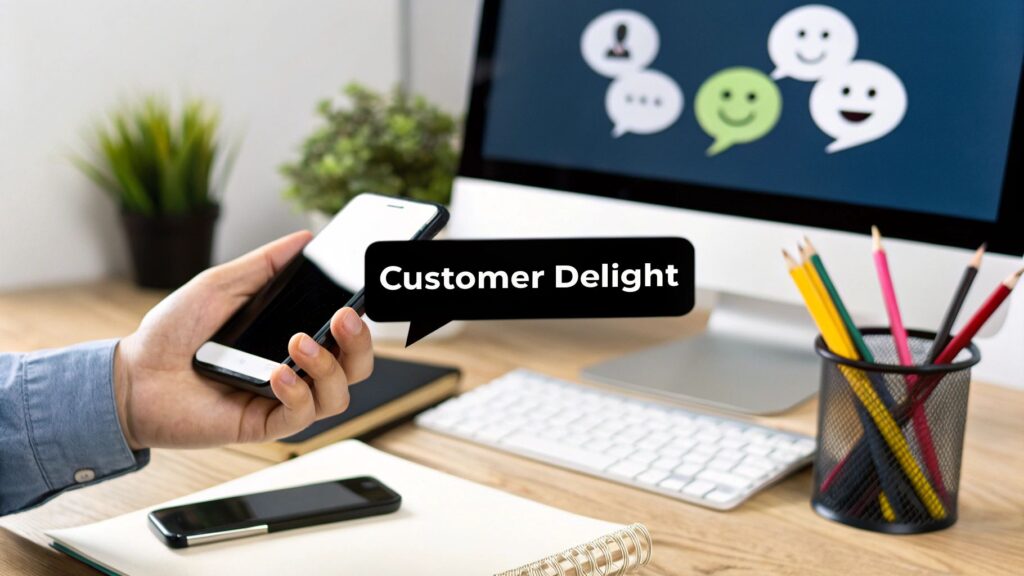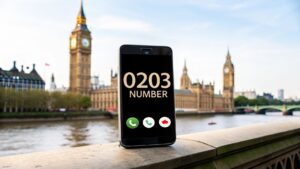If you want to genuinely improve your customer experience, you have to meet people where they already are. That means offering fast, personal, and convenient communication. For any UK business, this points directly to messaging apps, especially WhatsApp. It’s become the go-to for daily conversation, and now it's a critical frontline for how you interact with your customers.
Why WhatsApp Is the New Frontline for UK Customer Experience
Let’s be honest, the days of a customer patiently waiting on hold or being happy with an email reply inside 24 hours are long gone. People expect things instantly, and that absolutely includes customer service. Traditional channels just can't keep up anymore; they feel slow and disconnected in a world built on immediate communication. This is precisely where WhatsApp Business comes in, completely changing how companies can connect with their customers.
Think about it from your own point of view. You use WhatsApp to chat with friends and family because it’s quick, easy, and feels natural. By offering support on this same platform, you’re doing more than just providing a service – you're joining a conversation that’s already happening on your customer's favourite app. It’s a simple shift, but one that makes your brand feel far more accessible and human.
The Rise of Conversational Commerce
This move to platforms like WhatsApp isn't just a fleeting trend. It's a direct response to a massive change in how people behave. The UK’s digital retail scene has grown at a blistering pace, with online sales now accounting for over 27% of all retail sales in Great Britain.
With this shift, British shoppers have come to expect instant answers. In fact, a staggering 67% of UK shoppers demand a response to their questions within just two hours. This pressure skyrockets during huge retail events like Black Friday, Cyber Monday, and Boxing Day, when teams are swamped with enquiries but still need to deliver top-notch service. You can explore more about these UK customer service trends to see just how much expectations are shaping modern retail.
This screenshot from the official WhatsApp Business page really nails its core value: connecting with customers on the app they already love and trust.
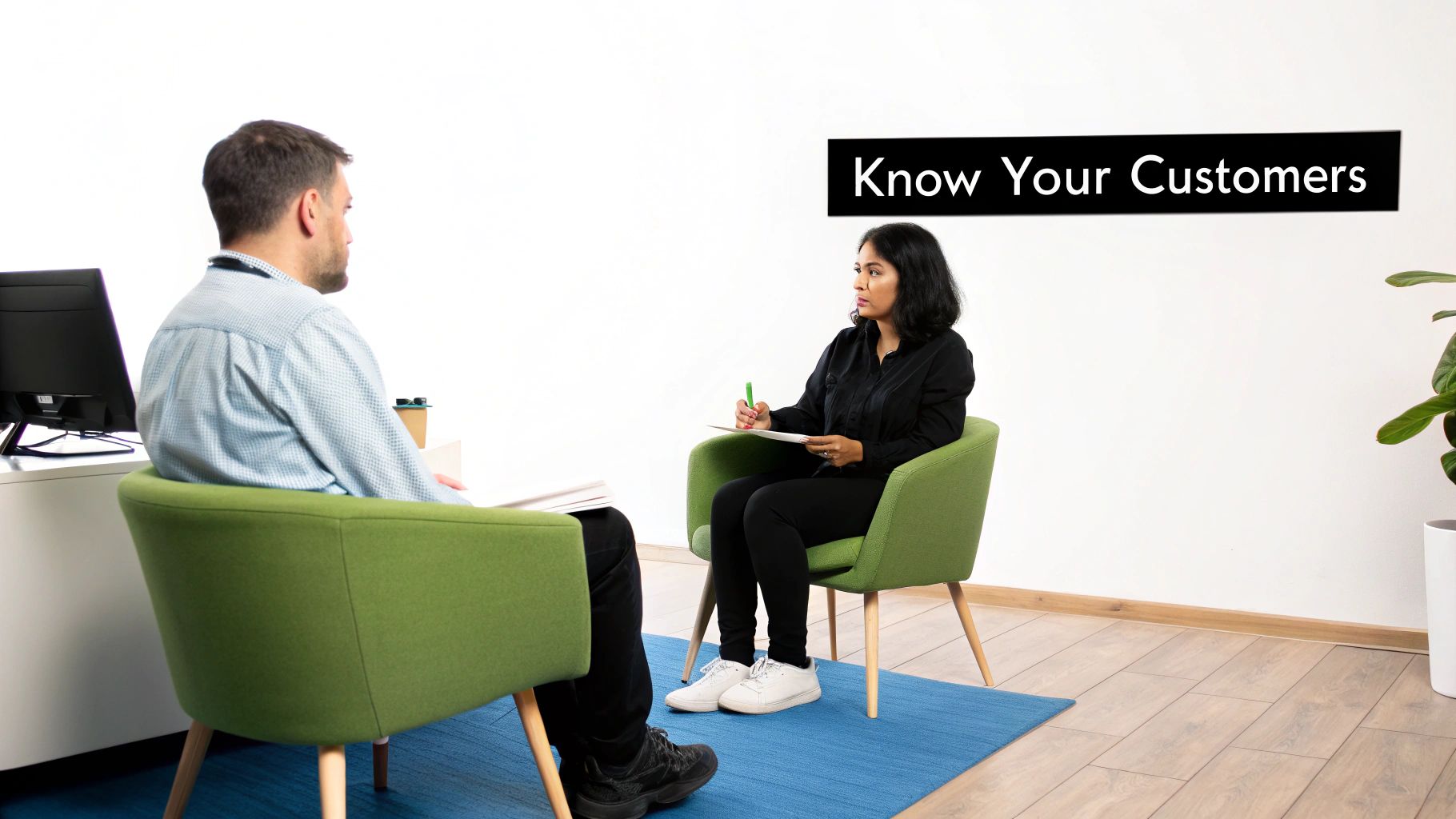
As you can see, it's not just a simple chat window. The image highlights powerful features like professional business profiles, product catalogues, and automated messaging – all designed to build an efficient and trustworthy presence right inside the app.
It's More Than Just Messaging
When you use a service like Business Numbers Direct to get a dedicated WhatsApp number, even a one-person operation can project a highly professional image. This isn't just about answering questions; it's about building an entire customer journey that feels completely seamless.
A great customer experience is no longer about isolated "wow" moments. It's about being dependable, making things easy, and being present in the channels your customers already use, time and time again.
By bringing WhatsApp into your communication strategy, you unlock some serious benefits:
- Boost Satisfaction: When you offer support on a familiar platform, you remove friction. Getting help becomes effortless, which customers love.
- Build Loyalty: Quick, personal interactions create a genuine connection. This is how you turn one-time buyers into loyal fans who stick around.
- Drive Sales: From browsing products in a catalogue to getting support after a purchase, WhatsApp can handle the entire sales cycle within one continuous, convenient conversation.
Getting Your WhatsApp Business Profile Ready for Customers
Once you’ve installed WhatsApp Business, the real work begins. This is where you move past the basics and start genuinely shaping the customer experience. Your profile is the first thing people see—think of it as your digital front door. It has to be professional, clear, and welcoming to build that crucial initial trust.
An incomplete profile with a fuzzy logo or a vague business description can make a potential customer think twice. On the other hand, a fully filled-out, polished profile shows you’re a serious, well-organised business that cares about its customers. Every detail, from your opening hours to your address, helps to smooth the path for people to do business with you.
Creating a Profile That Connects
That little business description box is your secret weapon. Don't just list your services. Instead, focus on the value you bring to your customers.
For example, a handyman shouldn't just write "Plumbing and electrical services." That's flat. Try something with more personality and a clear call to action: "Your reliable local handyman for all home repairs in Manchester. Fast, friendly service with guaranteed results. Tap to chat for a free, no-obligation quote!" See the difference? It's direct, reassuring, and tells them exactly what to do.
Your product catalogue is another brilliant feature. It lets customers browse your offerings right within the chat, without having to jump to a website. Make sure you use high-quality images, write detailed descriptions, and keep your prices current. This simple self-service feature respects your customer's time and gives them the power to find what they need, when they need it.
Ultimately, even with these great profile tools, it all comes back to creating a personal connection.
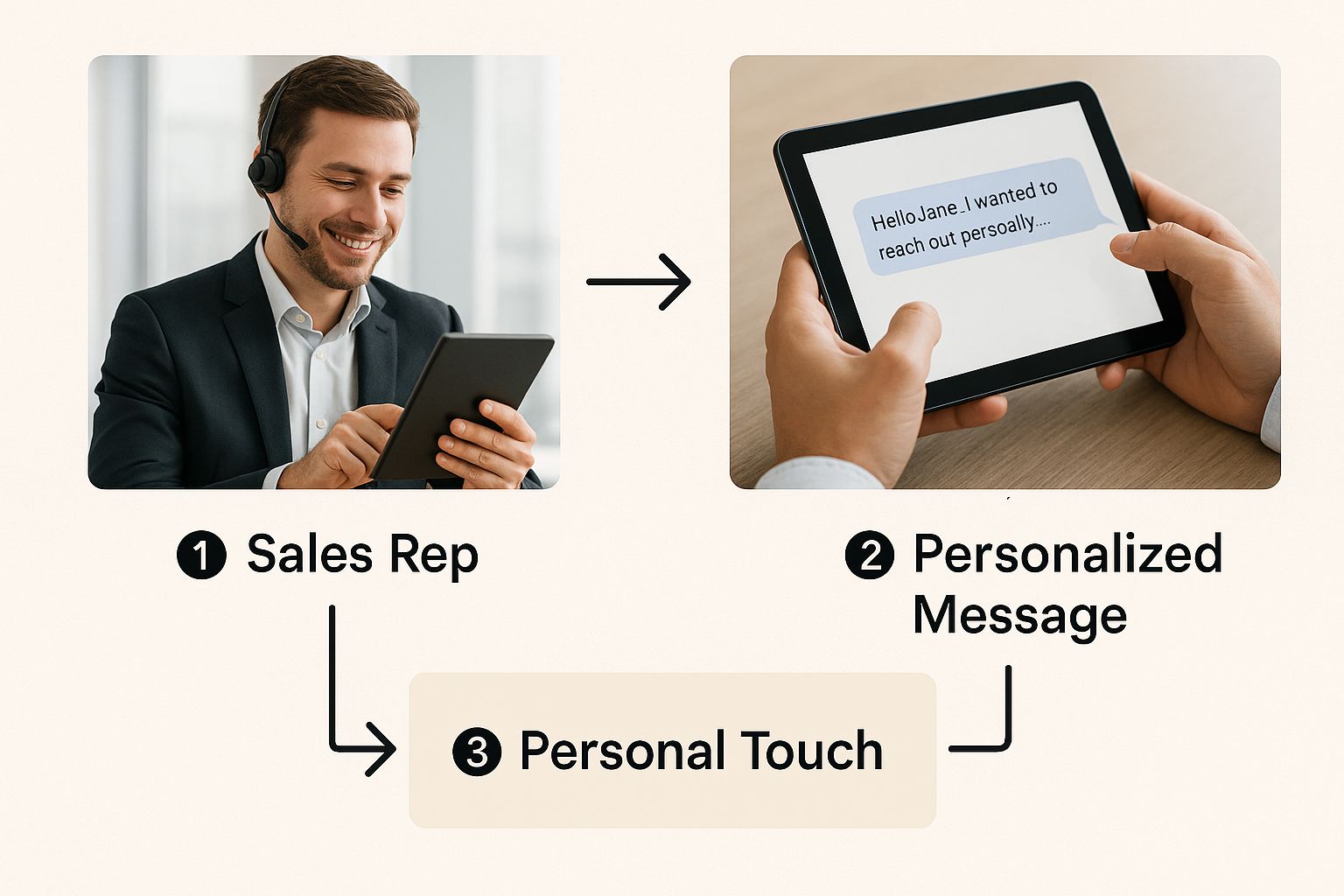
As the image shows, the goal isn't just to present information; it's to open the door for a one-to-one conversation that makes your customer feel seen and valued.
To help you get it right, here’s a quick checklist of the essential components for a top-notch WhatsApp Business profile. Getting these details right from the start makes a huge difference.
| Essential WhatsApp Business Profile Components |
| :— | :— | :— |
| Profile Element | Best Practice Tip | Impact on Customer Experience |
| Profile Picture | Use a clear, high-resolution company logo. | Instantly builds brand recognition and looks professional. |
| Business Name | Use your official, recognisable business name. | Avoids confusion and helps customers find you easily. |
| Business Description | Focus on value and include a call to action. | Quickly tells customers why they should choose you and what to do next. |
| Business Address | Pin your exact location on the map. | Builds local trust and makes it easy for customers to visit. |
| Business Category | Select the most accurate industry category. | Helps customers understand your business at a glance. |
| Opening Hours | Keep your hours accurate, especially for holidays. | Manages expectations and prevents frustration from unanswered messages. |
| Email & Website | Add your official email and website links. | Provides alternative contact methods and drives traffic to your site. |
Treating your profile as a key business asset, rather than just a setup task, pays dividends in customer trust and engagement down the line.
Using Labels to Organise Your Chats
As messages start rolling in, your inbox can get chaotic—fast. This is where labels become your best friend. They are essentially coloured tags you can attach to chats to sort them at a glance. It's a simple but incredibly effective feature for managing your workflow and making sure nobody gets missed.
A well-organised communication system is the backbone of a great customer experience. When your team knows the status of every conversation, responses are faster and more accurate, leading directly to higher satisfaction.
I've seen small businesses manage huge volumes of chats just by using a smart labelling system. Here are a few practical examples to get you started:
- New Enquiry: For anyone who has just reached out and needs a first response.
- Quote Sent: For customers you've sent a price to and are waiting on.
- Follow-Up Needed: A handy reminder to check back in with someone after a day or two.
- Order Placed: Makes it easy to find and update customers with active orders.
- Issue Resolved: For completed support chats, which helps you archive them and keep your main inbox tidy.
By using labels consistently, a solo entrepreneur can juggle dozens of conversations with the efficiency of a much bigger team. It ensures you always come across as professional and responsive, which is absolutely vital for building a positive customer relationship.
Automating Chats Without Sounding Like a Robot
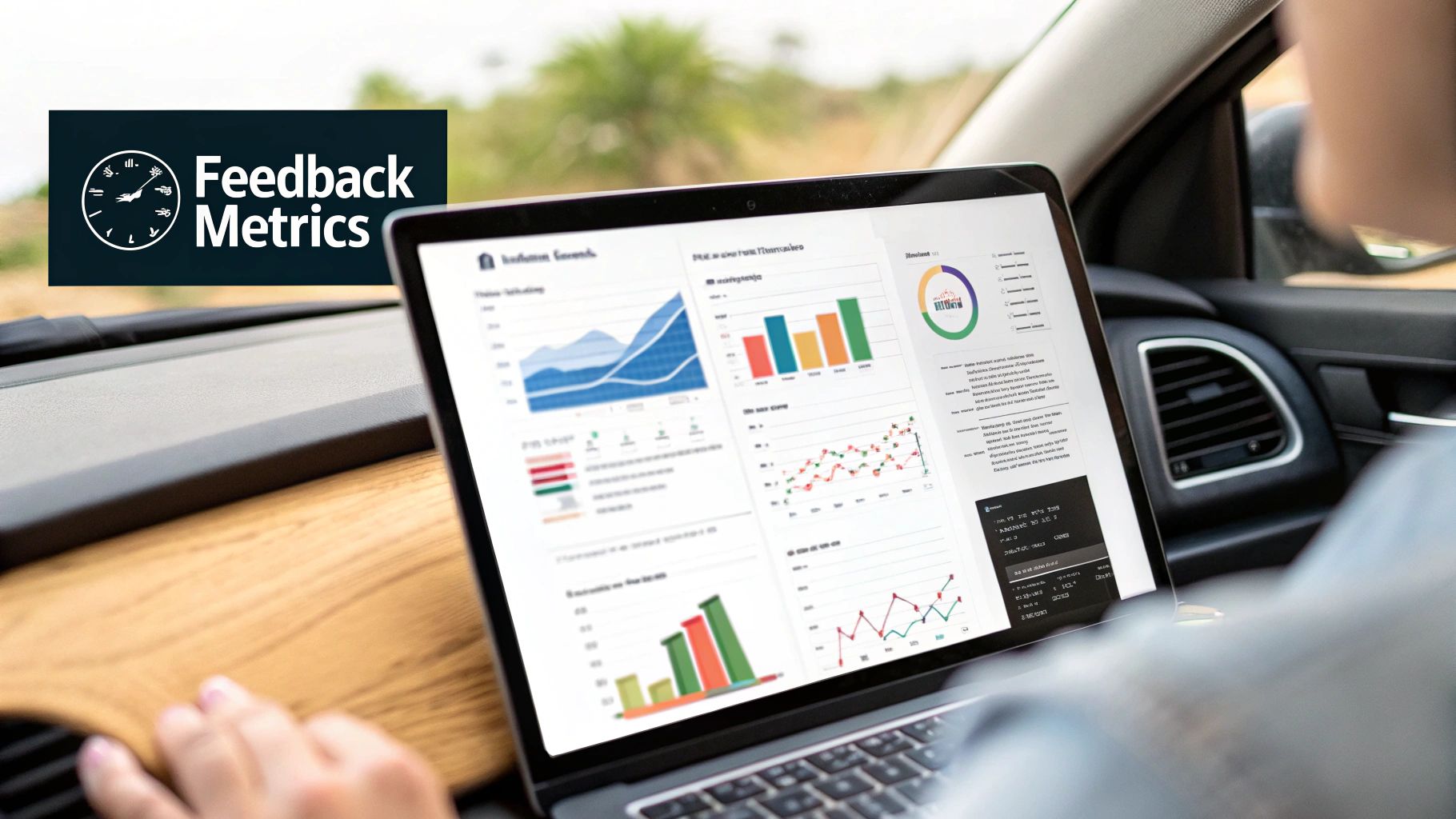
As a busy entrepreneur, you can't be chained to your phone all day. This is where the automation built into WhatsApp Business really shines. Features like greeting messages and quick replies let you provide instant responses, which can dramatically improve your customer’s experience.
The real trick is finding that sweet spot between efficiency and a genuine human touch. After all, nobody enjoys talking to a cold, impersonal bot. Your goal should be to create automated messages that sound like you, reflect your brand's personality, and are actually helpful.
This isn't just about being fast; it’s about meeting modern expectations. We've all seen how poor service can kill a sale. In the UK retail sector, for instance, a massive 80% of adults admitted to abandoning a purchase because of things like long queues or no staff to help. Online convenience has raised the bar, and customers now expect that same swift service from every business. You can read more about how customer experience impacts retail loyalty on taqt.com.
Crafting the Perfect Greeting Message
Think of your greeting message as your digital handshake. It’s often the very first automated interaction a new customer has with you. It’s your chance to make a fantastic first impression, let them know you’ve got their message, and manage their expectations about when you'll reply personally.
So, instead of a flat "We've received your message," try warming it up to match your brand's voice.
- For a local tradesperson: "Hi there! Thanks for getting in touch with Dave's Plumbing. I'm likely on a job right now, but I've got your message and will get back to you within two hours. Cheers, Dave."
- For an e-commerce store: "Hello! Thanks for your message. Our team is here to help Mon-Fri, 9 am-5 pm. We'll reply as soon as we’re back at our desks. In the meantime, have you seen our FAQ page? [Link to FAQ]"
See the difference? These examples feel friendly, set clear response times, and even point the customer towards a helpful next step.
Using Away Messages to Manage Expectations
Away messages are your best friend for those times you're genuinely unavailable, like after hours or during a bank holiday. A well-written away message stops customers from getting frustrated and shows that you respect their time.
A great away message isn't just an apology for being unavailable; it's a tool for building trust. It reassures the customer that they are important and their query will be handled as soon as you return.
Here’s how to make your away messages work harder for you:
- Be specific about your return: "Our studio is closed for the bank holiday weekend, but we'll be back and ready to help on Tuesday morning."
- Point them to self-service options: "While we're away, feel free to browse our full product catalogue right here in WhatsApp!"
- Include an emergency contact if it makes sense for your business: "If this is an urgent maintenance issue, please call our emergency line at 0800 123 4567."
Solving Problems Instantly with Quick Replies
Quick replies are your secret weapon for incredible efficiency. They're pre-saved templates you can pop into a chat with a simple shortcut (like typing "/hours"). They're absolutely perfect for answering those frequently asked questions in a flash.
Some of the most common uses for quick replies I've seen are:
- Business hours
- Location or address details
- Bank details for payments
- Links to your website or social media profiles
- Answers to common questions about products or services
By building a library of thoughtful, clearly written quick replies, you can slash your response times and solve common problems in seconds. This frees you up to give your full attention to more complex customer needs. For any small business looking to provide top-notch service, this simple feature is a total game-changer.
Building Real Customer Loyalty Through Personalisation
Once you’ve nailed the basics of communication, it’s time to focus on what truly makes a difference. This is where you shift from just having conversations to building genuine, lasting relationships. When you use WhatsApp for thoughtful, personalised engagement, you can completely change how customers perceive your brand, turning simple transactions into real loyalty.
This means going way beyond just dropping a customer’s first name into a template. Real personalisation is about knowing their history with your business and using that insight to offer something genuinely useful. The aim is to make your customers feel seen and valued, not just like another entry in your contacts list.
Thinking Beyond Standard Support
The secret to effective personalisation is relevance. While broadcast lists on WhatsApp are a fantastic tool, you have to use them smartly. Blasting a generic, one-size-fits-all message to everyone is a surefire way to get blocked. The magic really happens when you segment your audience and send targeted updates that matter to specific groups.
For instance, picture a local boutique that uses labels to tag customers who bought a particular brand of jacket. A week later, they could send a broadcast message just to that group, sharing a short style guide on how to wear it for different occasions. This isn’t a pushy sales message; it’s helpful content that adds value to their original purchase.
Or think about a service-based business, like a gas fitter. After an annual boiler service, they could proactively send a helpful tip about radiator efficiency a few months later, just before winter sets in. It’s a small, thoughtful gesture that shows you’re still thinking about their needs long after you've been paid.
These are the kinds of personal touches that create memorable moments. They prove you’re not just chasing the next sale but are genuinely invested in your customer's long-term satisfaction. This is how you improve customer experience and build a community of people who will champion your brand.
The Power of Being Proactive and Personal
Delivering a consistently high-quality experience is no longer a bonus; it's the baseline expectation for UK customers. In fact, the standard for customer experience excellence has been remarkably stable for years, which tells us that consumers have a clear idea of what they expect from brands. Research from KPMG shows how Customer Experience Excellence (CEE) scores in the UK have hovered around the same mark for the best part of a decade. You can dive deeper into the findings in the UK Customer Experience Excellence Report from kpmg.com.
To really stand out, you need to do more than just meet expectations. Personalisation is your best bet for exceeding them. Here are a few practical ideas you can put into action using a tool like Business Numbers Direct:
- Follow-Up After Purchase: A simple message sent a week after delivery can make a huge impact. Something like, "Hi [Name], just checking in to see how you're getting on with your new ?" opens the door for valuable feedback and shows you genuinely care.
- Share Exclusive Content: A freelance web designer could send a list of new SEO tips exclusively to clients whose websites they built more than six months ago. It’s relevant, helpful, and keeps them top of mind.
- Give VIPs Early Access: Use labels to create a "VIP" group for your most loyal customers. You can then offer them early access to sales or new product launches with a personal WhatsApp message.
These strategies don’t demand a massive marketing budget. All they really need is a bit of organisation and a genuine desire to be helpful. By thoughtfully using the information your customers have already given you, you can craft messages that feel less like marketing and more like helpful advice from a trusted expert.
Common Questions About Using WhatsApp for Business
Whenever you bring a new tool into your business, questions are bound to pop up. It’s completely normal. Getting straightforward, practical answers is the key to using WhatsApp with confidence and really making it work for your customer experience. Let’s walk through some of the most common queries we hear from UK businesses.
Is It Compliant with GDPR to Contact Customers on WhatsApp in the UK?
Yes, but this is a big one and you can’t afford to get it wrong: you must have explicit and provable consent before you send marketing messages to a customer on WhatsApp. This isn't a grey area. They need to actively agree to hear from you on this platform for promotional content.
A simple and effective way to handle this is by adding a checkbox to your website's contact or checkout forms. Make it crystal clear what they're signing up for – things like order updates, support chats, or exclusive offers. And crucially, always give them an easy way to opt out later. Keeping a clear record of when and how they gave consent is absolutely vital for staying on the right side of UK GDPR.
Gaining permission first is more than just a legal hoop to jump through; it's a sign of respect. It builds the foundation for a trusting relationship and a much better customer experience from the very first hello.
Can a Small Business Manage High Chat Volumes on WhatsApp?
Absolutely. The standard WhatsApp Business app is designed specifically for small to medium-sized businesses, and it's surprisingly powerful for managing a growing number of conversations.
You have some brilliant tools at your fingertips.
- Quick Replies are a lifesaver for answering those common questions in a flash.
- Labels help you organise your chats so no one slips through the cracks. For instance, you can tag chats as "New Enquiry" or "Follow-Up Needed" to keep your workflow tidy.
Once your business really starts to grow, you can move up to the WhatsApp Business Platform (API). That's when you can unlock serious automation and link it to your CRM, letting you handle practically any volume of messages without breaking a sweat.
What Are the Biggest Mistakes to Avoid on WhatsApp?
The number one mistake we see is spamming. If a message isn't genuinely relevant and valuable to the person receiving it, don't send it. Full stop. Always respect their time and the permission they gave you.
Another classic error is treating WhatsApp purely as a one-way sales megaphone. Its real power is in conversation, offering support, and actually building a relationship. Think of it less as a billboard and more as a direct line.
Finally, don't leave people hanging. Customers messaging you on WhatsApp expect a speedy response. If you can't reply right away, set up an automated away message. It manages their expectations and shows you’ve received their message and will get back to them soon.
Ready to create a professional, private, and efficient way to talk to your customers? You can get a dedicated number for WhatsApp Business in under five minutes with Business Numbers Direct. Keep your work and personal life separate while giving your customers the first-class service they deserve. Find out more at https://www.businessnumbersdirect.com.

